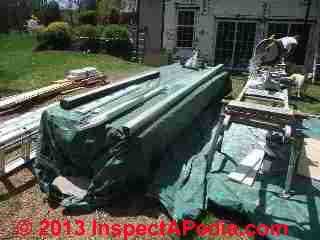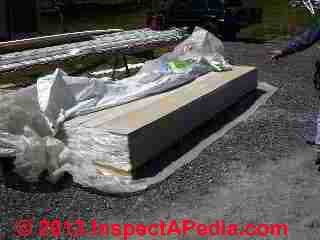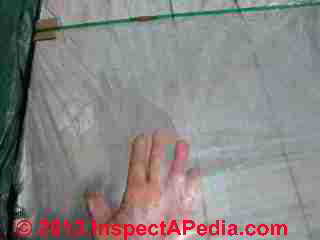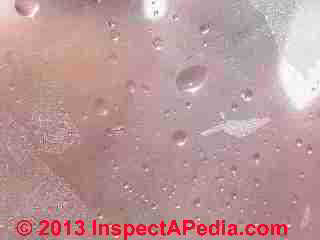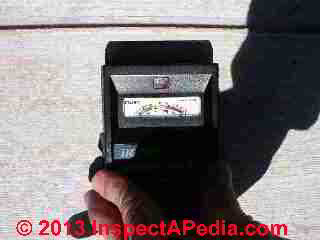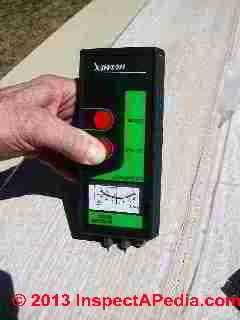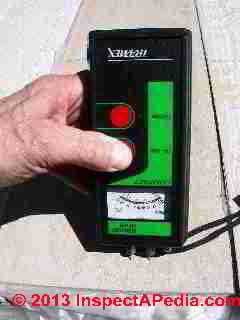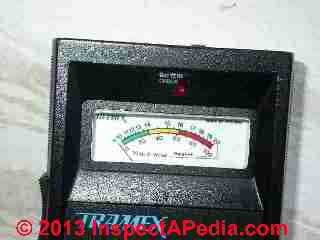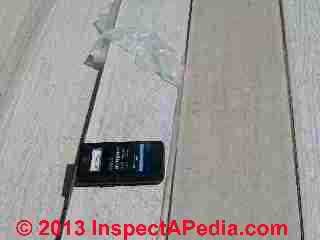 Fiber Cement Siding Moisture Levels / Wetness
Fiber Cement Siding Moisture Levels / Wetness
How, when, & why to measure fiber cement siding moisture level. How wet is "too wet to install"?
- POST a QUESTION or COMMENT about the cause & cure of butt joint gaps in fiber-cement siding & about fiber cement siding installation
Fiber cement siding moisture problems: fiber cement manufacturers advise that the product should not be installed if it is wet. Doing so can lead to unsightly butt joint gaps in siding courses as the product dries on the building. But how to figure out what wet actually means can be tricky.
We include diagnostic inspection photos and in related articles cited here we explain how to recognize, diagnose, and cure this problem.
We organize & include fiber cement siding gap repair advice from the manufacturer as well as from builders and building inspectors. We provide a table of all fiber cement siding installation clearance or gap specifications, caulking requirements & storage or moisture requirements.
InspectAPedia tolerates no conflicts of interest. We have no relationship with advertisers, products, or services discussed at this website.
Examining the Visible & Measured Moisture of Hardieplank Fiber Cement Siding on the Job
Lots of building products may be at a too-high moisture content without being visibly wet to the eye or even to touch by hand. And important if we're going to avoid moisture problems with any siding material is figuring out where the problem water or moisture is coming from.
Common sources of wet fiber cement siding products are said to be improper handling or storage before or at the job site. But as the study reported here shows, on occasion you may be getting wet fiber cement siding right from the supplier or even right from the siding factory.
Following the removal of "counterfeit siding" that had shrunk, leaving ugly butt joint gaps and disappointing the building owners of a property in Dutchess County, New York, the contractor, Galow Homes, ordered new Hardieplank™ siding from a local building supplier.
At Eric's suggestion, we inspected the Hardieplank™ siding when it was delivered and we monitored its performance during and after installation in 2013. There were some surprises!
Two pallets of fiber cement siding were delivered to the job: an incomplete bundle that had been re-wrapped in clear polyethylene plastic, presumably by the local supplier, and a complete bundle that was still in its original, un-damaged, un-torn, factory-sealed plastic wrapper. On opening the fiber cement after delivery we could plainly see, even without moisture measurement, that the products were wet!
At delivery, the siding was stored outdoors, off the ground, and for "insurance" against bad weather, the contractor wrapped additional plastic tarps around the material at the time of delivery (below left).
The second bundle that had been in its original factory wrapper is shown at left just after we began to open this package for examination of the siding itself.
Definition of "too wet" fiber cement siding
The manufacturer told us that the material must be kept dry and "not installed" if the contractor thinks it's "wet".
But despite repeated begging, we could not get the slightest definition of "wet" or "too much moisture" or "dry" fiber cement siding from the service rep with whom we spoke.
The same factory rep, in the company's warranty claims department, told us that the fiber cement siding moisture cannot be measured, a statement which is nonsense, see Hardieplank Technical Bulletin No. 8 found below in this article. Using a proper instrument and with proper precautions it is indeed possible to make relative moisture measurements in fiber cement products even without a clear industry standard. With a bit of work one could also make calibrated moisture measurements of product moisture.
At MOISTURE METER STUDY we provide details about using moisture meters, moisture meter scales, calibration, and accuracy.
Measuring Relative Moisture Content in Samples of Fiber Cement Lap Siding
Measuring moisture using a pin-type moisture meter is inaccurate for cementious products into which the pins don't penetrate, but a Tramex Moisture Encounter® or similar electronic moisture meter can give comparative moisture levels in cementious materials even without calibration to obtain an actual moisture percentage. [23]
Certainly relying on visible water alone would not be enough to define a siding product as "too wet to install" as products may look dry but have very high moisture content.
But in this case we found visible water in droplet form and sheer "wet" areas soaking the interior surfaces of both the distributor-wrapped and the factory wrapped plastic wrappers on this fiber cement siding on the day it was delivered to the job site.
Above you can see my hand wiping away water found on the inside of the plastic wrapper.
In response to a series of inquiry calls, the factory rep [S.] advised that in such cases the contractor should refuse the delivery and stop the job - advice that unfortunately fails to consider the drastic cost to owner, supplier, and in particular the contractor when a long-scheduled job has to be scrapped to wait for new materials without any assurance that the replacement will be any better!
What we would have preferred is some guidance on how to assess the moisture in fiber cement siding products, and perhaps a discussion with the various manufacturers (it's likely every one faces these concerns) about product drying, wrapping, shipping, and storage before and during installation.
I thought the factory rep would want to know that the product had arrived visibly wet and that refusing the material and cancellling the job was a very costly proposition, moreso if the existing siding has already been stripped from a building to prepare it for installation of the new material.
Her advice, delivered in an impressively nasty tone, was for the owner, or perhaps the contractor to "Put in a claim". In other words, "Buzz off, buster!" While we found slightly better data and encounterd no such rudeness when inquiring about a different product, (DRYWALL MOLD RESISTANT) there too we found a similar lack of clarity about "excessive moisture" exposure.
Causes of Wet Fiber Cement Siding - at Delivery
Where did this water come from? It would appear to be coming from the fiber cement siding itself, as we found these conditions in the factory-wrapped product as well as the distributor-wrapped siding.
Our electronic moisture meter, set on the "cement" scale, was quite capable of making relative moisture comparisons among various examples of fiber cement siding.
In the photo at left you can see that we are reading in the "wet" end of the scale. As a comparison point, on the same scale the garage floor, building sheathing, and other samples measured in the green or "dry" end of the instrument's range.
We measured the fiber cement siding relative moisture content at the board ends and center, and then began lifting boards out of the bundle to measure siding boards in the center of the pallet.
Variations in Fiber Cement Siding Moisture Confirm the Point of Origin of the "Wet" Material
Significantly, the fiber cement siding boards near the top of the bundle measured as much lower in moisture content than those in the center of the bundle - a strong argument for the moisture source as the product itself. We suspect the product may have b een wrapped and shipped from the factory while still rather high in moisture.
Measurements of surface moisture can be made using a pin-type moisture meter (shown below) and those, too, confirmed that these fiber cement boards were more wet at the board center than at the bundle ends, and boards in the center of the whole bundle were more wet than those on the bundle top layer or two.
At above left you can see the pin type moisture meter reading in the center of its wetness scale (center of a board) and at above right, at the dry end of its scale near the board end. [Click to enlarge any image].
Watch out: we do not recommend using pin- type of moisture meters for making comparative moisture level measurements fiber cement products: stick with an electronic unit such as the Tramex Moisture Encounter. Other factors such as ambient and test material temperature, even type of paint coating can affect the reading of moisture meters, particularly pin-type meters.
However, for demonstrating relative moisture or for comparing siding moisture to a known dry example, even relative moisture meter readings can be perfectly adequate.
Moisture meter techniques & sources of error are discussed in detail at MOISTURE METER STUDY.
Without calibration to a known source, moisture meter readings taken on fiber cement siding products are relative, not absolute in percent moisture content for this material, though being cementious, probably the cement or masonry scale on the moisture meter is not far off.
Finally, for a fiber cement siding board comparison measurement, we took a look at the moisture content of a "dry" fiber cement siding board that was several years old, had been removed from the building, and had been stored indoors for several months.
You'll notice that the moisture meter in use above indicated very low moisture content in this similar product when it was in fact "dry".
What About Laying the Damp or Wet Siding Out to Dry
When the parties ruled out leaving the home naked to wait for new siding that might in fact show up just as wet as the present material, we discussed steps to try to dry out the siding to a lower moisture content before its installation.
We calculated that spreading out all of the siding indoors to dry was out of the question. The total square feet of all sides of a typical two story home far exceeds the available indoor conditioned space to lay out all of the material to dry.
We had observed that left in the sun on a bright dry day, placed on a clean dry plastic tarp outdoors, siding boards driedf to a relatively very low moisture content, possibly low enough for safe installation. Sadly , for practical reasons the contractor pointed out that spreading out all of the siding in the sun to "dry" was just a crazy idea.
The job would require thousands of square feet of dry tarped surface all in the sun;
The siding would have to be laid out when the sun was up but stacked again and put away at the end of the day - until the material was both dry and installed on the building. The time and labor for this step, even if there was adequate space and tarps, was more than the time to install the siding on the building. And the repeated handling risked product damage.
Other Steps to Minimize Butt Joint Shrinkage Gaps
In addition to installing only "dry" siding (whatever that actually is - in the absence of an actual factory specification of measurable moisture content or moisture content expressed in percentages that map to common electronic moisture meters), the contractor should make every effort to minimize the number of butt joint gaps - focusing instead on using the factory-specified clearances (and caulking) at abutting vertical trim on the building.
Watch out: when installing long runs of continuous siding may avoid shrinkage gaps but if enough end clearance is not provided at the board ends there may be thermal expansion and buckling problems. We discuss these below.
Will the contractor continue to recommend the selection & installation of this product type? We'll see.
Bottom line on Fiber Cement Siding Moisture & Shrinkage:
- Don't assume that a fiber cement siding product delivered from the factory is dry enough to install without worry about butt joint shrinkage gaps.
- Don't expect to always find a friendly reception from factory reps when contact at a company's Warranty Claims service center. And expect to have to spend time and effort to find a knowledgable technical expert who will talk with you whether you're a contractor or homeowner.
- Be sure to review the product installation specifications with care, to follow the manufacturer's instructions, and to discuss the fiber cement siding product moisture content concern, shrinkage, and product handling with the company's representative and with your supplier. Follow the manufacturer's storage and installation instructions for the product.
- Expect some fiber cement siding butt joint gaps to appear. See FIBER CEMENT SIDING GAP CURES
HardiePlank Thermal or Moisture Expansion Properties: shrinkage gaps vs. expansion buckling
In addition to moisture-related shrinkage and butt joint gap concerns discussed above and traced to the dry-out of too-wet siding at time of its installation, some installations of fiber cement lap siding as well just about every other building siding material may experience buckling or bulging due to thermal or moisture-related expansion, particularly on very long horizontal siding runs and particularly if the material is not installed according to the manufacturer's recommendations.
While these details are not in the product installation instructions (as of June 2013), the company has issued James Hardie Technical Bulletin No. 8 addressing this topic. Excerpting from the company's data, :
Fiber cement (complying with ASTM C1186), as do all building materials, expands and contracts with changes in relative humidity and temperature. James Hardie recommends designing for this type of movement on buildings with long runs of continuous siding. Coefficient of Thermal Expansion (COTE) per ASTM E228 is:
- Longitudinal COTE = 6.7X10E-6 in/in ° F
- Transverse COTE = 7.65X10E-6 in/in ° F
- Moisture movement per ASTM C1185 (30% RH to 90% RH) is: 0.05% of length. [18]
Note that this rather modest total moisture movement over the length of the siding product refers to cyclic movement due to normal moisture conditions in a properly stored, installed, coated, sealed, and flashed product.
At SIDING, FIBER CEMENT GAPS we discusse more significant moment that can appear as gaps at siding butt joints and caused most likely by improper storage or coating.
Reader Question: Gaps at Butt Joints in fiber cement lap siding
I had CertainTeed factory painted fibre cement siding installed on my new home last year. The installer, contrary to the CertainTeed installation instructions, left a 1/8" gap at all butt joints. He now maintains that CertainTeed and other contractors state that a 1\4" gap at butt joints is acceptable.
... I maintain that the requirement by CertainTeed to not leave a gap of any kind is to greatly minimize any shrinkage that might subsequently occur at the butt joints. - M.D 4/11/13
Reply: 3 causes of gaps at lab siding butt joints in fiber cement installations
You are partly correct. The product specifications call for no gap at fiber cement lap siding butt joints, but it's not the gaps that cause shrinkage but rather product shrinkage that causes these gaps or increases their width as the product dries on the building. My OPINION from what I've learned both by field investigation and by reading the various manufacturer's installation instructions & technical bulletins is that there are three distinct sources butt joint gaps in fiber cement siding installations:
- Improper siding installation (leaving gaps where they should not be)
- Siding shrinkage (probably excessive product moisture at the time of installation)
- Thermal movement of siding (not usually significant, but a possible source of buckling and gaps at the lapped edges in long continuous siding runs)
A complete discussion of the question above, including factory specifications for siding clearances and gaps, the causes & cures of butt joint gaps, and lap siding butt joint gap repairs are found at SIDING, FIBER CEMENT GAPS and its companion articles.
...
Continue reading at SIDING, FIBER CEMENT REMOVAL or select a topic from the closely-related articles below, or see the complete ARTICLE INDEX.
Or see these
Recommnded Articles
- SIDING, FIBER CEMENT
- CERTAINTEED WeatherBoards™
- CHINESE fiber cement siding
- FIBER CEMENT SIDING PAINTS
- FIBER CEMENT SHINGLE CUTTING TOOLS
- FIBER CEMENT SHINGLE REPAIRS
- JAMES HARDIEPLANK® FC SIDING
- NICHIHA ™ FIBER CEMENT SIDING FIELD REPORT
- SIDING CLEARANCE TO GROUND
- SIDING FIBER CEMENT COEFFICIENTS of EXPANSION
- SIDING, FIBER CEMENT CURL / LIFT DEFECTS
- SIDING, FIBER CEMENT DEFECTS - home
- SIDING, FIBER CEMENT DEFECT DIAGNOSTIC QUESTIONS
- SIDING, FIBER CEMENT GAP & CAULK SPECS
- SIDING, FIBER CEMENT GAPS
- SIDING, FIBER CEMENT GAP CURES
- SIDING, FIBER CEMENT IDENTIFICATION
- SIDING, FIBER CEMENT MAINTENANCE
- SIDING, FIBER CEMENT MOISTURE ABSORPTION
- SIDING, FIBER CEMENT MOISTURE LEVELS
- SIDING, FIBER CEMENT REMOVAL
- SIDING, FIBER CEMENT BOARD REPAIRS
- FIBER CEMENT PRODUCT MANUFACTURERS
- FIBER CEMENT PRODUCT STANDARDS
- FIBER CEMENT ROOF SHINGLE ASBESTOS TEST RESULTS
SIDING HARDBOARD IDENTIFICATION & CLAIMS
Suggested citation for this web page
SIDING, FIBER CEMENT MOISTURE LEVELS at InspectApedia.com - online encyclopedia of building & environmental inspection, testing, diagnosis, repair, & problem prevention advice.
Or see this
INDEX to RELATED ARTICLES: ARTICLE INDEX to BUILDING SIDING
Or use the SEARCH BOX found below to Ask a Question or Search InspectApedia
Ask a Question or Search InspectApedia
Try the search box just below, or if you prefer, post a question or comment in the Comments box below and we will respond promptly.
Search the InspectApedia website
Note: appearance of your Comment below may be delayed: if your comment contains an image, photograph, web link, or text that looks to the software as if it might be a web link, your posting will appear after it has been approved by a moderator. Apologies for the delay.
Only one image can be added per comment but you can post as many comments, and therefore images, as you like.
You will not receive a notification when a response to your question has been posted.
Please bookmark this page to make it easy for you to check back for our response.
Our Comment Box is provided by Countable Web Productions countable.ca
Citations & References
In addition to any citations in the article above, a full list is available on request.
- James Hardie Fiber Cement Siding Best Practices, Appendix A, (2014) [PDF] available from James Hardie Corporation, 231 S. LaSalle St., Suite 2000
- [1] "James Hardie's Mesothelioma and Asbestos Legacy Continues, 2009", web search 03/01/2011, www.survivingmesothelioma.com
- [2] Killer Company, James Hardie Exposed, Matt Peacock, Harper Collins Australia, ISBN: 9780733325809; ISBN10: 0733325807
- [3] " Anyone else have HardiePlank siding on their house?", Early Retirement.org online blog, retrieved 1/14/2013, original source: http://www.early-retirement.org/forums/f27/anyone-else-have- HardiePlank-siding-on-their-house-19475.html
- [4] - DIY Chatroom, retrieved 1/17/2013, original source http://www.diychatroom.com/f2/ certainteed-weatherboard-vs-HardiePlank-4638/
- [5] Certainteed Weatherboard fiber cement siding and trim products - see certainteed.com/ or see certainteed.com/resources/sidingandtrimspecsheet.pdf
- [5a] "CertainTeed WeatherBoards™ Fiber Cement Siding Installation Manual", CertainTeed Corporation, 2012, CertainTeed Corporation, PO Box 880, Valley Forge PA 19482, Professional Help Line: 800-233-8990, Consumer Help Line: 800-782-8777, Website: Certainteed.com www.certainteed.com/resources/fc017.pdf retrieved 4/11/2013, [copy on file as Certainteed_Fiber_Cement_Siding_Install_fc017.pdf ]
- [5b] "Certainteed WeatherBoards™ Fiber Cement Siding Best Practices for Effective Job Site Management", CertainTeed Corporation, retrieved 4/15/13 original source: www.certainteed.com Copy on file as Certainteed_FC_Handling Brochure-Contractor_FC063.pdf
- [5c] Personal communication, M. Smith, CertainTeed Corp, Customer Service, to D Friedman 4/16/2013
- [5d] Consumer Services CertainTeed Corporation 803 Belden Road Jackson, MI 49203 Toll Free #: 800.999.3654 Fax #: 517.787.0023 Email: jtc.conservfc@saint-gobain.com
- [5d] Identification of Certinteed fiber cement siding, personal conversation, Certainteed rep (Mitch in customer service) with D. Friedman, 4/16/2013, Tel: 800-233-8990. All Certainteed siding products have numbers imprinted on the obverse side. Woodgrain in a characteristic pattern (a specific knot) can be used to identify installed product. The product is produced up to 12" wide products (giving a 10 3/4" reveal), with the 9 1/4" wide boards providing an 8" reveal and 8 1/2" wide boards giving a 7" reveal. I also spoke with nattie Smith.
- [6] "Moisture Control in buildings: Putting Building Science in Green Building," Alex Wilson, Environmental Building News, Vol. 12. No. 5. [Good tutorial, "Moisture 101" outlining the physics of moisture movement in buildings and a good but incomplete list of general suggestions for moisture control - inadequate attention given to exterior conditions such as roof and surface drainage defects which are among the most-common sources of building moisture and water entry.--DJF]
- [7] J. Tibbets, "Green Houses", NCBI, retrieved 1/17/2013, original source: http://www.ncbi.nlm.nih.gov/pmc/articles/PMC1469482/
- [8] Gleeson et al, "Fiber Cement :Building Materials with Low Density Additives", U.S. Patent 8,182,606, B2 5/22/2012, [adding low volumes of volcanic ash & hollow ceramic microspheres to cellulose fiber-reinforced building materials.
- [9] Thanks to reader Marie Carr for James HardiePlank siding photograph and case history information. 06/01/2008
- [10] JamesHardie HardiePlank® Lap Siding information can be found at the company's web page on this material:
https://www.jameshardie.com/products_siding_hardieplankLapSiding.py - [11] "30-Year Limited Warranty
HardiePlank® HZ5® Lap Siding, HardiePanel® HZ5® Vertical Siding,
HardieShingle® HZ5® Siding, HardieSoffit® HZ5® Panels", 1-800-9-HARDIE
10901 Elm Avenue Fontana, CA 92337, retrieved 1/18/2013, original source: https://www.jameshardie.com/pdf/warranty/hz5.pdf [copy on file as Hardieplank_Warranty_hz5.pdf] - [12] James Hardie Building Products, James Hardie CustomerLink™ Service Centre, 10 Colquhoun Street, Rosehill NSW 2142, Tel: 13 1103, Outside Australia 61 2 8837 4709,
Fax: 1 800 818 819. Hardie has operations in Australia, Asia, Canada, Europe, New Zealand, United States, and the Philippines. The company is a significant producer of fiber cement siding and backerboard. Email: info@JamesHardie.com and Website https://www.jameshardie.com/
- JamesHardie Corporation, in the U.S. can be contacted at 26300 La Alameda, Suite 400,
Mission Viejo, California 92691 -
1-888 J-HARDIE
1-888 542-7343 or by email to info@JamesHardie.com - [12b] "Technical Bulletin #9, Joint Flashing at Field Butt Joints", JamesHardie, retrieved 4/15/2013, original source: www.jameshardie.com, copy on file as James_Hardie_9-joint-flashing.pdf - quoting:
This Technical Bulletin is an explanation supporting the announcement made by James Hardie on September 8th, 2008 withdrawing its recommendation on the use of caulk at field butt joints for HardiePlank® lap siding. - [12] Hardiplank James Hardie warranty claims information:Tel: (866) 375-8603, Email: claims.administration@jameshardie.com
- JamesHardie Corporation, in the U.S. can be contacted at 26300 La Alameda, Suite 400,
Mission Viejo, California 92691 -
1-888 J-HARDIE
- [13] Instructions for application of HardiePlank lap siding can be found at https://www.jameshardie.com/products_siding_hardieplankLapSiding.py?openTab=jsnavLink4
- [14] "Homeowners Care and Maintenance Tips", 1-800-9-HARDIE
10901 Elm Avenue Fontana, CA 92337, included with product warranty information, retrieved 1/18/2013, original source: https://www.jameshardie.com/pdf/warranty/hz5.pdf [copy on file as Hardieplank_Warranty_hz5.pdf] - [15] "HardiePlank HZ5 Lap Siding Installation Requirements - Primed & Colorplus® Products",JamesHardie, November 2012, 1-800-9-HARDIE, 10901 Elm Avenue Fontana, CA 92337, retrieved 1/18/2013, original source: https://www.jameshardie.com/pdf/install/hardieplank-hz5.pdf, [copy on file as Hardieplank-hz5_Install.pdf]
- [16] Technical Bulletin #9, Joint Flashing at Field Butt Joints, James Hardie corporation, retrieved 1/19/2013, original source: https://www.jameshardie.com/pdf/technical-bulletins/9-joint-flashing.pdf
- [17] Technical Bulletin #17, Fastening Tips for HardiePlank® Lap Siding, James Hardie Corporation, retrieved 1/19/2013, original source: https://www.jameshardie.com/pdf/technical-bulletins/17 -fastening-tips-for%20-plank.pdf [copy on file]
- [18] Technical Bulletin #8, Expansion Characteristics of James Hardie® Siding Products, James Hardie Corporation, retrieved 1/19/2013, original source: https://www.jameshardie.com/pdf/technical-bulletins/8-expansion-characteristics.pdf [copy on file]
- [19] Eric Galow, Galow Homes, Lagrangeville, NY. Mr. Galow can be reached by email: ericgalow@gmail.com or by telephone: 914-474-6613. Mr. Galow specializes in residential construction including both new homes and repairs, renovations, and additions. Personal communication 3/20/2013.
- [20] Johnston, Colin D., Fiber-reinforced cements and concretes. Vol. 3., Taylor & Francis, (CRC Press) 2000. ISBN-10: 9056996940 ISBN-13: 978-9056996949, "This book summarizes and simplifies the results of a considerable body of research and practical experience with a wide range of fiber-reinforced cementitious composites."
- [21] Hugh Cairns, Subject 2 Home Inspections, is a professional home inspector in British Columbia, Canada, with offices in Kelowna B.C. and Kamloops B.C. He contributed the American Cemwood photo used at the top and within this article. Mr. Cairns can be contacted by telephone: 250-808-5777, or by email: okanagan@subject2homeinspections.com
- [22] Roger Xu, 徐银杰 (my Chinese name), Ningbo Yihe Greenboard Co., Ltd., No.189, Longzhen Road, Nongkenchang, Longshan Town, Cixi, Ningbo, Zhejiang China, Tel: 0086-574-63974118/83887668 Fax:0086-574-63974129/83887670 Mobile: 0086-15924317823; E-Mail: sales6@yhboard.com; Skype: dajiezi107, www.yhboard.com/en, personal correspondence 3/21/2013
- [23] James Hardieplank, personal communication with Daniel Friedman, 6/6/2013. We called James Hardie to ask for guidance in determining just how much moisture was "too much" in Hardieplank siding, after observing that siding at a job arrived visibly wet from the factory even though still inside its original sealed plastic wrapping. We called James Hardie's technical support line [888-542-7343] where a courteous representative told us he would refer us to Hardie's expert Benjaman Batres.
Our call to Mr. Batres [909-349-2976] on 6/6/13 was returned by Stephanie (who declined to give last name) from James Hardie's customer warranty service department. Stephanie informed us in no uncertain terms that there are no moisture numbers or moisture level number guidance for their product, that it is not possible to measure moisture in fiber cement siding (a remark which is utter nonsense!) and repeatedly advised "Just read our instructions" or "So file a claim". Don't count on much help from James Hardie's customer warranty department on siding shrinkage or butt joint gap concerns. Gaps at Hardieplank siding butt joints continue to appear in the Hardieplank installation.
Stephanie' advice that "if the siding arrives wet, just refuse it" is difficult to follow since there is no definition of "wet" or of an acceptable moisture level. And the advice is a real thumb-in-the-eye to any contractor whose income depends on successfully scheduling work. Sending back materials can leave a contractor idle or missing other jobs that were put off to do the one that now has no materials to install.
Finally, Stephnie told us that "the owner can file a claim" if they are not happy with siding shrinkage and gap problems. Stephanie concluded her advice with "This conversation is ending." - MASONITE WOODRUF® ROOFING OR MASONITE OMNIWOOD® SIDING LAWSUIT SETTLEMENT NOTICE - PDF file
- Paint Handbook: testing, selection, application, troubleshooting, surface preparation, etc., Guy E. Weismantel, Ed., McGraw Hill Book Company, 1981, ISBN-10: 0070690618, ISBN-13: 978-0070690615, [Excellent but a bit obsolete paint theory and practice, also a bit light on field investigation methods, out of print, available used-DF]
How to select and apply the right paint or coating for any surface. The first major reference to help you choose the correct paint or other finish to do the job best on a particular surface exposed to a particular environment. Experts in the field give full advice on testing surface preparation, application, corrosion prevention, and troubleshooting. The handbook covers wood, metal, composites, and masonry, as well as marine applications and roof coatings. A ``must'' working tool for contractors, architects, engineers, specification writers, and paint dealers. - Paint and Surface Coatings, Theory and Practice, R. Lambourne & T.A. Strivens, Ed., Woodhead Publishing Ltd., William Andrew Publishing, 1999 ISBN 1-85573-348 X & 1-884207-73-1 [This is perhaps the leading reference on modern paints and coatings, but is a difficult text to obtain, and is a bit short on field investigation methods - DF]
Provides a comprehensive reference source for all those in the paint industry, paint manufacturers and raw materials suppliers, undergraduate and postgraduate students, and industrial paint users. R. Lambourne was in the Research Department at ICI Paints Division and the Industrial Colloid Advisory Group, Birstol University, UK. - Seeing Through Paintings, Physical Examination in Art Historical Studies, Andrea Kirsh, Rustin S. Levenson, Materials in Fine Arts, 2000 ISBN 99-051835 [ forensic science, technical reference, focused on art works - DF]
- Staining, Prevention of Premature Staining in New buildings, Phil Parnham, Taylor & Francis; 1996, ISBN-10: 0419171304, ISBN-13: 978-0419171300
The appearance of ugly staining early in a buildings life, ruins an otherwise pleasing appearance, tarnishes the image of the owners and gives rise to costly refurbishment works. In this book Phil Parnham raises a number of questions that should be considered whenever a new building is being designed or built. These are: * why has staining become so prominent; * what causes premature staining; which parts of new buildings are likely to be affected; * how can it be avoided? By using a number of highly illustrated case studies, the author answers these questions and ends by suggesting measures that should be taken by all design and construction professionals to prevent premature staining. - Our recommended books about building & mechanical systems design, inspection, problem diagnosis, and repair, and about indoor environment and IAQ testing, diagnosis, and cleanup are at the InspectAPedia Bookstore. Also see our Book Reviews - InspectAPedia.
- In addition to citations & references found in this article, see the research citations given at the end of the related articles found at our suggested
CONTINUE READING or RECOMMENDED ARTICLES.
- Carson, Dunlop & Associates Ltd., 120 Carlton Street Suite 407, Toronto ON M5A 4K2. Tel: (416) 964-9415 1-800-268-7070 Email: info@carsondunlop.com. Alan Carson is a past president of ASHI, the American Society of Home Inspectors.
Thanks to Alan Carson and Bob Dunlop, for permission for InspectAPedia to use text excerpts from The HOME REFERENCE BOOK - the Encyclopedia of Homes and to use illustrations from The ILLUSTRATED HOME .
Carson Dunlop Associates provides extensive home inspection education and report writing material. In gratitude we provide links to tsome Carson Dunlop Associates products and services.


